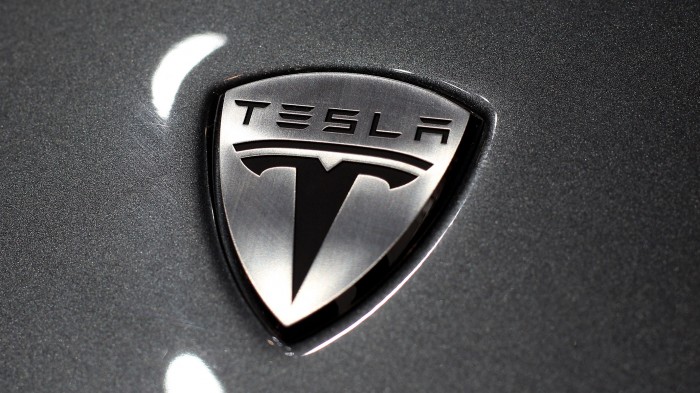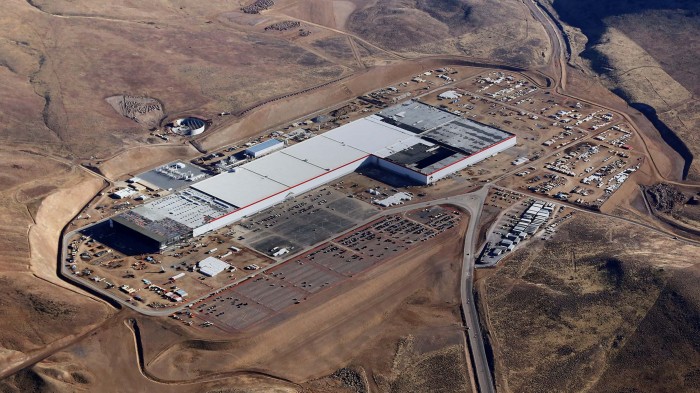Tesla’s Model 3 Is a Long Way from Elon Musk’s Grand Goal

Eleven years ago, Elon Musk laid out a grandiose, three-point plan for a niche electric car startup known as Tesla Motors. The company would deliver three vehicles at successively lower prices, funneling cash from sales of its sports car and luxury sedan back into research and development, driving down costs and speeding up the timeline for the ultimate goal: an all-electric, low-cost family car.
Only once clean vehicles reached the mass market could the company achieve what Musk saw as Tesla's overarching purpose: expediting the shift from "a mine-and-burn hydrocarbon economy towards a solar electric economy" (see “Elon Musk’s House of Gigacards”).
On Friday, against all reasonable expectations a decade ago, the company will arrive at the final step of that initial plan. During a carefully staged event at its manufacturing facility in Fremont, California, Tesla will deliver the first of its long-awaited Model 3s to several dozen early customers. The four-door sedan starts at $35,000 before incentives, with a range of 215 miles per charge.
You can quibble over whether that's genuinely affordable (auto observers would generally call it “entry-level luxury”). But there's little doubt the vehicle will lure a wider mix of customers to electric vehicles—and no dispute that Tesla has already reshaped the automobile market. The company helped make plug-in vehicles appealing in a nation infatuated with brawny, gas-guzzling cars and trucks, forcing other manufacturers to initiate or accelerate their own EV plans.
But arriving at step three, of course, is very far from fulfilling Musk’s grander vision. For all the rapid recent growth, electric vehicles are still a tiny market, representing less than 1 percent of new sales globally.
Electric vehicles will almost certainly grab a swelling portion of the auto market in the years ahead. But it will be a long time before they tip into the truly mainstream, and longer still before they could meaningfully reduce the sector’s dependence on those hydrocarbons.
Many things still need to change in underlying infrastructure, consumer appetites, public policies, and battery prices before any of this can happen. And there is wide disagreement about how fast that’s likely to unfold, and where Tesla will stand once it does (see “Tesla’s Next Broken Promise”).

A bevy of batteries
As ever, count Musk as the optimist on these scores.
Earlier this month, during an onstage interview at the 2017 National Governors Association Summer Meeting in Rhode Island, he predicted that more than half of all new cars produced in the United States will be electric “probably in 10 years.” That’s more than a decade ahead of most optimistic estimates.
To put Musk’s forecast into context, half of U.S. demand in 2027 would add up to 9.1 million electric vehicles, based on Bloomberg New Energy Finance estimates. If those all ran on 60 kilowatt-hour lithium-ion battery packs—reportedly the standard package for the Model 3—it would require enough manufacturing capacity to produce 546 gigawatt-hours’ worth of battery packs annually. And that's just for the United States market.
To put that into context, worldwide EV battery production stands at only 90 gigawatt-hour today, and there's only 270 gigawatt-hours in the planning or construction phases, according to BNEF.
Initially, Tesla said its massive “gigafactory” in Sparks, Nevada, would produce 50 gigawatt-hours’ worth of battery packs per year, but more recently raised its projection for final capacity to 150 gigawatt-hours. That means achieving Musk’s goal would require companies to plan and build four to 16 additional gigafactory-scale operations just for U.S. car production, all within the next decade (see “Does Musk’s Gigafactory Make Sense?”). Tesla's first factory is expected to be fully operational in 2020, meaning it took six years to complete from the time it was announced. The company's second gigafactory is primarily dedicated to producing solar panels, but the company said that three more factory sites could be disclosed by the end of this year, presumably devoted to batteries. Attempting to add anywhere near that level of manufacturing capacity will, of course, further extend a company already carrying a hefty debt load—an issue that could pose real risks should Tesla encounter unexpected headwinds (see “Tesla’s Money Problems Are No Surprise”).
The company didn't respond to an inquiry from MIT Technology Review.
Colin McKerracher, head of transport analysis at BNEF, expects U.S. demand for electric vehicles to reach only 3.2 million by 2027, less than 18 percent of the total, though he does say a successful Model 3 launch could accelerate adoption. According to his models, it'll take another decade to cross Musk’s halfway threshold, reaching 54 percent on a global basis in 2040.
Consumer tastes
Anything approaching 50 percent penetration, whether in 10 years or 23, will require radical shifts in consumer preferences.
U.S. auto sales reached a record high in 2016. But trucks and SUVs led the way once again, accounting for 63 percent of transactions, driven in part by low gas prices. None of that suggests that a giant portion of American consumers are clamoring for plug-in cars, which still entail some clear disadvantages.
"They're more expensive, they don't drive as far, and it takes time to recharge," says Jeremy Michalek, director of the Vehicle Electrification Group at Carnegie Mellon University. “You have enthusiasts, but for mainstream consumers it's still just an inferior product."
Of course, there’s still only a handful of electric vehicle models available in the U.S., including Tesla’s high-end Model S and Model X, the Ford Focus Electric, and the recently released $36,496 Chevy Bolt, which managed to beat Musk to the quasi-entry-level market segment. But a growing number of manufacturers are going after the space, with some two dozen models debuting at last fall’s Paris Motor Show. Volvo recently announced all of its vehicles will have an electric motor by 2019 (which includes “mild hybrids”), and it will launch five new all-electric models by 2021.
If the Model 3 is a hit, it may well grab market share from other internal combustion engine cars around the same price point, and encourage more manufacturers to bulk up their EV offerings, McKerracher says.
Still, BNEF predicts that mass-market adoption will occur in most markets only once electric cars reach price parity with internal combustion engines. That’s not likely to happen on an unsubsidized basis until 2025, at which point the research group expects lithium-ion batteries to have reached $109 per kilowatt hour, down from $273 last year.
But not everyone agrees battery prices—and by extension, EV costs—will fall that fast. Michalek’s research found that most of the big price declines from manufacturing EV batteries at larger scales have already occurred. Any additional steep declines will require technological innovations, which are harder to accurately forecast, he says.
The other force that could drive down costs, and accelerate adoption, would be more supportive public policies. Some U.S. states are pushing hard, including California, where legislators recently proposed adding another $3 billion in subsidies on top of already sizable state EV tax credits. But any additional federal policies pushing adoption aren’t likely to pass under the current administration and Congress.
Another critical challenge surrounding electric vehicles is charging infrastructure. Widening the market beyond the well-to-do means attracting apartment dwellers as well as homeowners. They don’t necessarily have their own parking lots or garages—or a strong desire to spend hundreds or thousands of dollars installing charging capacity on someone else’s property.

Public policies and resources could help accelerate the necessary changes on this front as well. Various nations, states, and cities are already trying assorted approaches, including requiring new construction to include charging capacity, or adding publicly funded curbside charging.
An accommodating grid
Researchers generally believe existing U.S. energy generation can accommodate a vast number of electric cars. A 2007 study by the Pacific Northwest National Laboratory found that without adding a new plant or transmission line, the U.S. grid could reliably charge 84 percent of the nation’s cars, pickups, and SUVs.
That continues to hold true, but does require managing the grid in more efficient ways, says Michael Kintner-Meyer, a co-author of that study. Notably, utilities will need to employ price incentives or technological tools to ensure EV owners are charging their battery packs during the night—rather than, say, all at once after work.
That load balancing, however, raises an interesting issue: In much of the country, the cheap, flexible power sources at night are often coal-fired power plants. That means you could actually end up with higher greenhouse emissions from a particularly dirty energy source, Carnegie Mellon’s Michalek notes.
And that gets us to the fundamental challenge facing Musk’s larger vision of using electric vehicles to green the transportation sector. Cars and trucks that don’t burn fossil fuels—whether they run on lithium-ion batteries, fuel cells, or some other technology—will be a necessary condition for achieving that goal. But they’re nowhere close to a sufficient one.
The vehicles will only be as clean as the power sources used to charge them, and more than 80 percent of U.S. energy generation still comes from fossil fuels.
“In the long term, these technologies may be the only way we're able to reach these targets,” Michalek says. “But whether we actually reach them or not depends on what we do with the rest of the electricity system.”
Keep Reading
Most Popular
Large language models can do jaw-dropping things. But nobody knows exactly why.
And that's a problem. Figuring it out is one of the biggest scientific puzzles of our time and a crucial step towards controlling more powerful future models.
How scientists traced a mysterious covid case back to six toilets
When wastewater surveillance turns into a hunt for a single infected individual, the ethics get tricky.
The problem with plug-in hybrids? Their drivers.
Plug-in hybrids are often sold as a transition to EVs, but new data from Europe shows we’re still underestimating the emissions they produce.
Stay connected
Get the latest updates from
MIT Technology Review
Discover special offers, top stories, upcoming events, and more.